Grade Levels
4-7
Subjects
Language Arts, Science, Social Studies, Social Emotional Learning, Art, Media Literacy
Grade Levels
4-7
Subjects
Language Arts, Science, Social Studies, Social Emotional Learning, Art, Media Literacy
Squid Learning Guide

This episode features Dr. Sarah McAnulty, a biologist and squid scientist who helped to create Skype A Scientist.
We hope you enjoyed listening to our interview with Dr. Sarah McAnulty, a biologist and squid scientist, author of The Inkcredible Cephalopod Coloring Book, and founder of Skype a Scientist, an organization that provides opportunities to connect people to a variety of scientific experts.
Complete the activities below to learn more about one of the oldest and most interesting creatures on our planet Earth, find out about their cool adaptations and unique characteristics, and take action to make a difference in protecting squid and other endangered marine life.
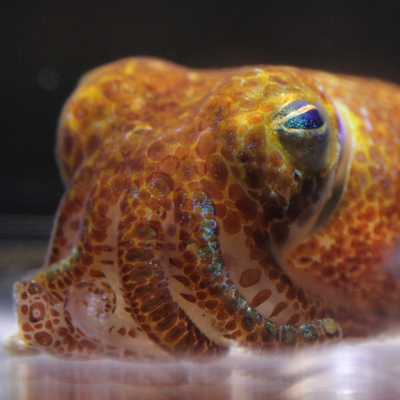
Squid vary greatly in size. There are more than 300 species of squid found in all depths of the ocean, everywhere on Earth.
Vocabulary
Vocabulary words can be found throughout the page in bold.
Invertebrates
Invertebrates are animals that do not have a backbone (spine). Examples of invertebrates include insects, worms, jellyfish, and squids.
Squid Adaptations
Special features or behaviors that squids have developed through evolution to help them survive in their environment. They can change color to communicate, squirt ink to hide from predators, and use their strong bodies to move quickly.
Sustainable Seafood Farming
A way of producing sea animals for food consumption in a way that minimizes harm to the ocean or the environment. For example, raising seafood without harming local water quality, using resources carefully, making decisions by considering impact on future generations, and assuring that the animals are treated well.
Evolution
The way living things slowly change over time to fit better in their environment.
Cephalopod
Cephalopods are a group of marine animals that have large heads, many arms or tentacles, and are known for their ability to change color and shape. They are also very smart creatures.
Marine Ecosystem
A marine ecosystem is a salt water environment that includes the open ocean, the deep parts of the ocean, any large saltwater body, and coastal areas near the shore. Each of these places has a different plants, animals, and conditions in which they live.
Squid Anotomy and Significance
Squid are invertebrates, meaning they are animals without a backbone or spine. They belong to the cephalopod family, which includes other marine animals like octopuses and cuttlefish. Cephalopods are known for their large heads, multiple arms or tentacles, ability to change color and shape, and remarkable intelligence. Interestingly, the word “squid” can be used to refer to one squid or a group of squid, but if you’re talking about different types of squid, you’d say “squids.” Squid come in a wide variety of sizes, ranging from just a few inches to more than 70 feet long!
Most of a squid’s body is a muscular, tube-shaped structure called the mantle. Long ago, squid had hard outer shells like snails, but over millions of years, these evolved into a softer, internal structure called a pen, which protects their organs. Squid have two long, strong tentacles that stay hidden until they shoot out to grab prey. These tentacles, lined with suction cups, pull the prey toward the squid’s shorter arms, which pass it to the mouth. The squid’s mouth contains a sharp beak that it uses to eat. The arms also help the squid steer as it swims, while two wing-like fins on the mantle help with steering and stability. Squid live in oceans all over the world, from shallow coastal waters to the deepest parts of the sea.
There are at least 300 known species of squid, and some have existed for over 500 million years. Squid are culturally, spiritually, and practically important to many people worldwide. In addition to being a food source, squid skin can be used to create materials for art, tools, nets, and clothing. Squid are often featured in art and artifacts, preserving cultural traditions and beliefs. For some Indigenous peoples of the Pacific Islands, Oceania, and the Arctic, squid represent a connection between the physical and spiritual worlds. Stories about squid often symbolize adaptability, transformation, mystery, and cleverness, teaching respect for the unknown forces of nature. Squid are a reminder of how to navigate challenges and adapt to life’s changes.
Activity: Squid Anatomy Review
Using information from the summary above, complete the activity page to find and label parts of squid and answer questions to show what you learned.
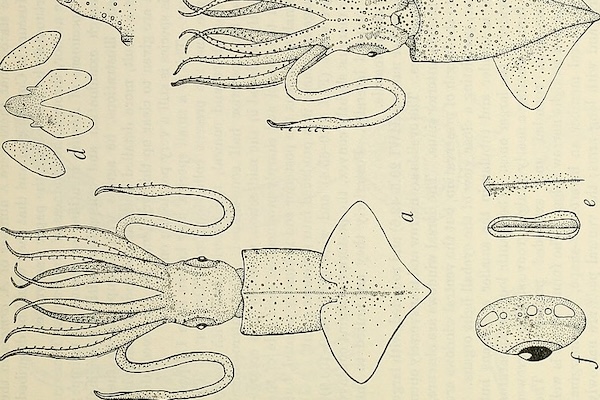
Squid have been studied by humans for thousands of years. Image from Wikimedia Commons.
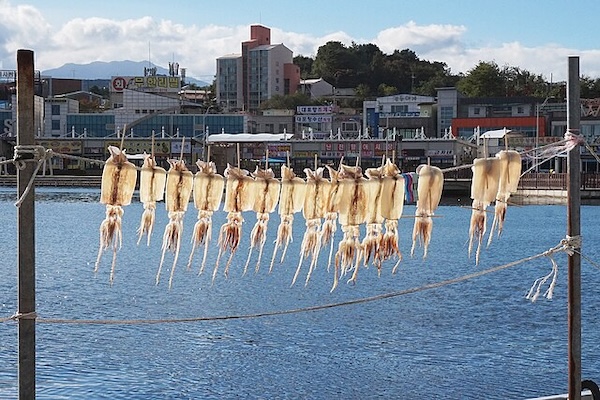
Squid preserves well through drying processes, here are squid drying on a line in South Korea. Image from Wikimedia Commons.
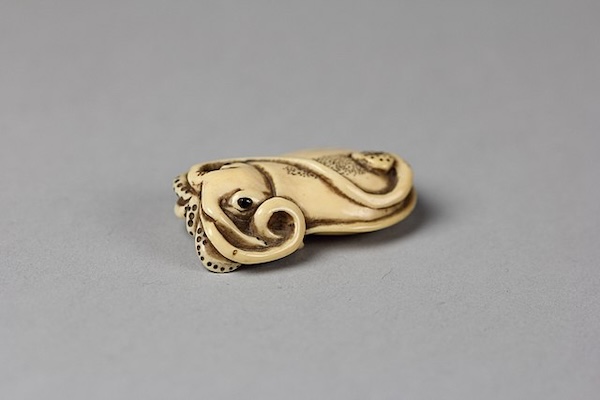
Squid are important to many cultures, here is an image of an artifact from 17th century Japan. Image from Wikimedia Commons
Squid Adaptations
There are many different types of squid who live in and have adapted to a variety of habitats. Squid adaptations are special features or behaviors that squids have developed through evolution to help them survive in their environment. Squids have many adaptations to evade their predators, catch prey, and advance as a species.
Here is a some examples of squid adaptations:
- Squid that dwell in deep waters have skin that has bioluminescence, or the ability to produce light through a chemical reaction, which can be used for social recognition and for attracting prey.
- Squid have two big eyes, and some can be as big as footballs. Their eyes are designed to help them see upwards and downwards at the same time, and to see in the deep ocean where there is very little light.
- Squid participate in organized social behavior such as alerting others of danger, hunting in large groups and taking part in social networks. Some squids connect groups while others stay more isolated.
- In murky waters where visibility is limited, squid use tiny hairs on their head and arms for sensing movement in the surrounding water.
- Squid can change colors thanks to their thousands of tiny organs called chromatophores which contain pigments. These organs are controlled by the squid’s muscles, in order to communicate with each other and to camouflage themselves in their environment.
- Squids can release ink composed of mucus and melanin. Some species have developed specialized strategies, such as creating a large ink cloud to obscure the view of a predator or prey. Others produce a blob-like decoy that distracts predators, luring them toward the fake target instead of the squid.
- Squids swim by rapidly expelling water from their mantle cavity through a funnel, generating a jet that propels them in the opposite direction. Their large nerve cells allow for fast reflexes. They have three hearts: two branchial hearts to oxygenate their gills, and one that circulates oxygenated blood throughout the body. Squids are among the fastest marine invertebrates, capable of rapid bursts of speed, which varies by species. Some scientists claim they can go 25 miles per hour.
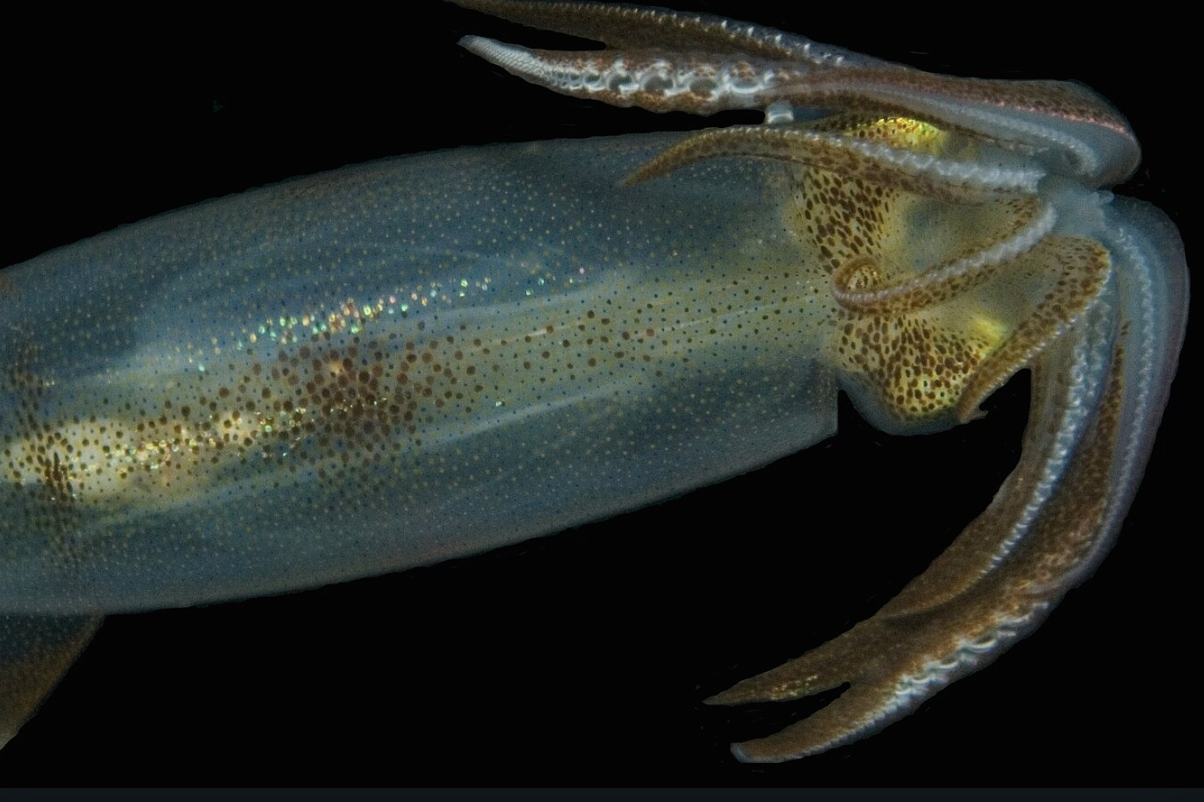
Squid that live in the deep ocean floor are bioluminescent and produce light. Image from Wikimedia Commons.
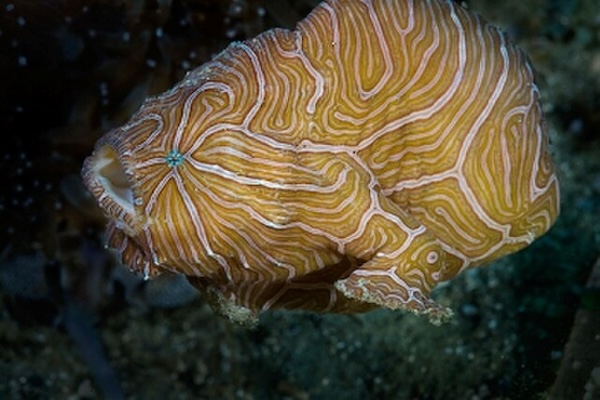
This frogfish is moving with jet propulsion. Image from Wikimedia Commons.
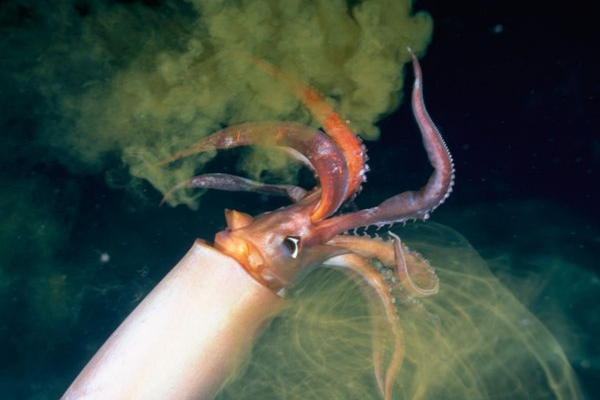
A jumbo squid squid releasing ink. Photo courtesy of National Geographic.
Activity: Animal Adaptation Inspired Invention
Complete the activity worksheet to imagine an invention inspired by an adaptation characteristic of squid.
Skype A Scientist
Newton’s Third Law of Motion says that for every action, there is an equal and opposite reaction. This means that when you push on something, it pushes back with the same amount of force, but in the opposite direction. Squids use this law to swim by shooting water out of their bodies, which pushes them forward. This same idea helps explain how rockets launch into space, how birds fly, and even how cars move. It’s an important rule that helps us understand many things in nature, science, and technology.
Many scientists today draw inspiration from Isaac Newton and other great thinkers from the past. Dr. Sarah McAnulty, recognizing the importance of inspiring the next generation of scientists, wanted kids to learn about careers in science, how science applies to different fields, what it’s like to be a scientist, and answers to their questions. To make this possible, she helped create Skype a Scientist, a program that connects people directly with scientists to share knowledge and spark curiosity.
Skype a Scientist is a program that connects scientists with classrooms, families, libraries, and other groups around the world through live video chats. It gives people a chance to talk directly with scientists, ask questions, and learn about different areas of science in a fun and interesting way. It helps make science easy to understand and exciting for everyone!
Activity: Prepare to Skype a Scientist
For this activity, imagine you have an opportunity to interview a scientist to learn about something that interests you. Use this guide to help you plan your interaction. Once your plan is ready, share with classmates, neighbors, friends, your family, or another group. Use this database to search for an available scientist, then complete this form to coordinate the interview. Find out more about how it works on the Skype a Scientist website. Have fun!

Researchers study a squid. Image from Wikimedia Commons.

Skype a Scientist in action in a photo taken of a classroom learning from a scientist. Photo from Skype A Scientist
Sustainable Seafood Farming
A marine ecosystem is a community of plants, animals, and other organisms that live in the ocean or other large bodies of saltwater. Everything in the ecosystem is interconnected and works together to survive, including fish, coral reefs, seaweed, and even the water itself. Squids play a vital role in maintaining balance in their local ecosystems and in the overall health of the ocean.
As predators, they help regulate populations of smaller marine animals like fish, shrimp, and plankton, using their powerful tentacles to catch prey and their sharp beaks to consume it. As prey, squids are a key food source for larger animals, including whales, seals, dolphins, seabirds, and big fish. Their role as both predator and prey helps maintain the balance of marine life in the ocean.
Humans are also part of the marine ecosystem and food chain because many people eat squid and other sea creatures. However, human activities, such as those that contribute to climate change, can harm squid populations. It’s important for people to protect the balance of the ecosystem, ensuring squid can continue to evolve and play their role in the ocean. After all, everything in nature is connected.
One way to help squid and other marine animals is by supporting sustainable seafood farming. This type of farming raises seafood for people to eat in ways that minimize harm to the ocean and the environment. It involves careful use of resources, protecting local water quality, treating animals responsibly, and making decisions that consider future generations. Some companies follow these practices more closely than others, so it’s important to choose seafood from sources that prioritize sustainability.
People can also practice conscious buying, which means making thoughtful choices about what to purchase to create a positive impact on society, the economy, and the environment. By supporting sustainable practices, we can help protect the ocean and the creatures that call it home.
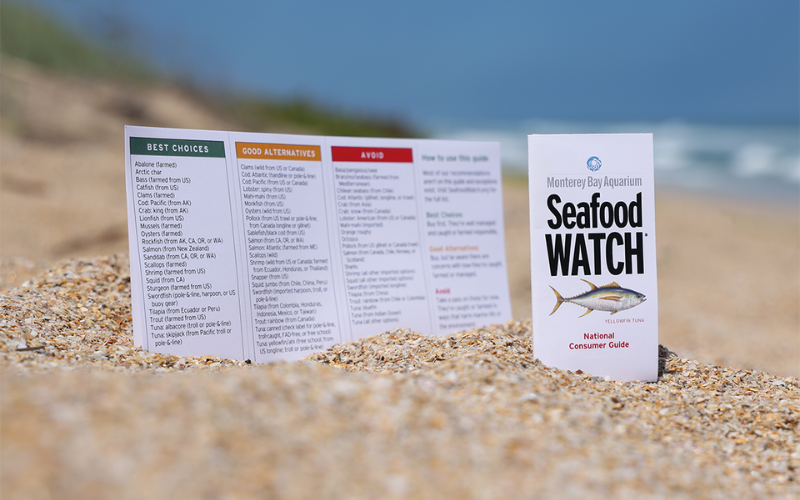
Seafood watch lists like this one from the Monterey Bay Aquarium share updated information regarding types of seafood that are better for the environment for people to consume.
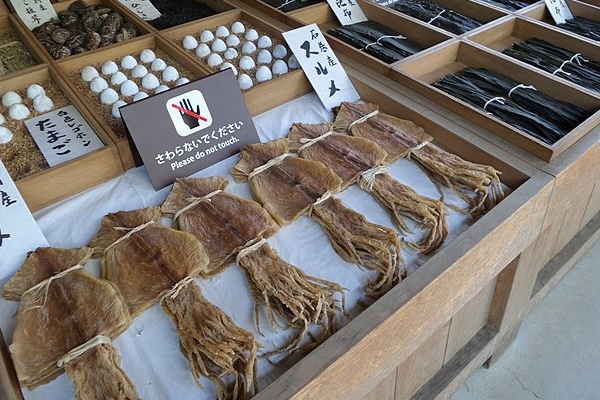
Challenge: Promote conscious buying in your community
There are many things that people can do to help preserve and protect endangered marine life. Your challenge is create a public service announcement, it can be a flyer, podcast episode, poster or create your own idea. The announcement should inform its viewers or listeners about how they can make purchasing decisions that support the environment. Start with thinking of a product you often buy, and do some research about the company to find out if they focus efforts on protecting the environment. Is there another supplier that is more environmentally friendly? If so, you can share this information with others in your PSA, and with us at The Children’s Hour so we can help promote your good idea.
Media Journal: Squid
Watch and Learn
After watching one or both of the videos, use the guiding questions to reflect on what you learned. Share your information with another person.
What did I already know about this topic?
What did I learn from the video?
What new questions do I have?
More Activities and Resources
Learn more about squid ink adaptations in the video: Sparkling Clouds and Other Wild Ways Cephalopods Use Ink.
Check out: In Search of Giant Squid, a Smithsonian online exhibit and extensive curriculum guide.
See how squid have evolved and learn more about their anatomy with this animation.
Practice drawing a squid with this video, this guide, and this step by step tutorial.
Explore images and other Primary Sources related to Squid.
Create some Kraken themed crafts with these ideas.
Engineer a jet propelling “cephalapod” with this Science Friday project.
Watch footage of a giant squid captured by scientists using advanded technology and underwater cameras.
Read an article about an example of squids migrating because of climate change.
See how squid swim in the wild in this video.
Learn about other cephalopods in this video.
Learn about the history and science of giant squid and colossal squid and how these amazing creatures inspire stories of the Kraken and other myths in the PBS show Monstrum.
©2023-2025 The Children’s Hour Inc., All Rights Reserved.
